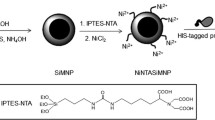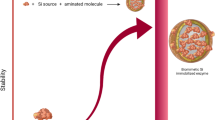Abstract
Biocatalysis presents a sound alternative to chemical synthesis in the field of drug production, given the highly selective nature of biological catalysts. Penicillin G Acylase (PGA) from E. coli is currently used to hydrolyze penicillin G (PG) and catalyzes the synthesis of β-lactam antibiotics. In this work, particular emphasis is given to recent developments in penicillin G acylase immobilization, by entrapment simultaneously with nano-magnetic particles in a silica matrix. The sol–gel biocatalytic particles were prepared either by a conventional method (crushed powder) or by a more recent approach, based in an emulsion system using 150 mM AOT/isooctane, which allowed for the formation of spherical micro- and nanobeads. The effects on PGA activity of different sol–gel precursors, additives, enzyme concentration, aging, drying conditions and mechanical stability were evaluated. After these optimization studies, a mechanically stable carrier based on porous xerogels silica matrixes, starting from tetramethoxysilane (TMOS) with 65–67% PGA activity yield in these carriers allowed an immobilization yield of 74 mg protein g −1dry sol–gel and 930 Ug −1dry sol–gel for specific activity were obtained.










Similar content being viewed by others
References
Cheetham PSJ (1995) The application of enzymes in industry. In: Wiseman A, Horwood Ellis (eds) Handbook of enzyme biotechnology. Wiley, London
Straathof AJJ, Panke S, Schmid A (2002) The production of fine chemicals by biotransformations. Curr Opin Biotechnol 13:548–556
Giordano RC, Ribeiro MPA, Giordano RLC (2006) Kinetics of β-lactam antibiotics synthesis by penicillin G acylase (PGA) from the viewpoint of the industrial enzymatic reactor optimization. Biotecchnol Adv 24:27–41
Jin X, Wu Q, Chen Q, Chen C-X, Lin X-F (2008) Immobilization of penicillin G acylase on a composite carrier with a biocompatible microenvironment of chitosan. J Chem Techonol Biotechnol 83:1710–1716
Shewale JG, Sivaraman H (1989) Penicillin acylase: enzyme production and its application in the manufacture of 6-APA. Process Biochem 24:146–154
Sun H, Bao XY, Zhao XS (2009) Immobilization of penicillin G acylase on oxirane-modified mesoporous silicas. Langmuir 25:1807–1812
Serenovic L, Stankovic N, Spizzo P, Basso A et al (2006) Highlevel production and covalent immobilization of Providencia rettgeri Penicillin G Acylase (PAC) from recombinant Pichia pastoris for the development of a novel and stable biocatalyst of industrial applicability. Biotechnol Bioeng 93:344–354
Ignatova Z, Wischnewski F, Notbohm H, Kasche V (2005) Pro-sequence and Ca2+ -binding: implications for folding and maturation of Ntn-hydrolase Penicillin Amidase from E. coli. J Mol Biol 348:999–1014
Duggleby HJ, Tolley SP, Hill CP, Dodson EJ, Dodson G, Moody PCE (1995) Penicillin acylase has a single amino acid catalytic centre. Nature 373:264–268
Arroyo M, de la Mata I, Acebal C (2003) Biotechnological applications of penicillin acylases: state-of-the-art. Appl Microbiol Biotechnol 60:507–514
Illanes A (2004) Optimization of cephalexin synthesis with immobilized penicillin acylase in ethylene glycol medium at low temperatures. J Mol Catal B Enzym 30:95–103
Sheldon RA (2007) Enzyme immobilization: the quest for optimum performance. Adv Synth Catal 349:1289–1307
Mateo C, Palomo JM, Fernandez-Lorente G, Guisan JM, Fernandez-Lafuente R (2007) Improvement of enzyme activity, stability and selectivity via immobilization techniques. Enz Microb Technol 40:1451–1463
Cabral JMS, Kennedy JF (1993). In: Gupta MN (ed). Thermostability of enzymes. Springer, Berlin
Schroën CGPH, Eldin MSM, Janssen AEM, Mita GD, Tramper J (2001) Cephalexin synthesis by immobilised penicillin G acylase under non-isothermal conditions: reduction of diffusion limitation. J Mol Catal B Enzym 15:163–172
Kallenberg AI, van Rantwijk F, Sheldon RA (2005) Immobilization of penicillin G acylase: the-linked enzyme aggregates (CLEAs): a novel and versatile method for enzyme immobilization (a review). Biocatal Biotrandformation 23(3/4):141–147
Yu HW, Chen H, Wang X, Yang YY, Ching CB (2006) Cross-linked enzyme aggregates (CLEAs) with controlled particles: application to Candida rugosa lipase. J Mol Catal B Enzym 43:124–127
Betancor L, Luckarift HR (2007) Biosilica-immobilized enzymes for biocatalysis. In: Palomo JM (ed) Recent advances in biocatalysis and biotransformation. Research Signpost, Florida
Sheldon RA, Schoevaart R, Van Langen LM (2005) Cross-linked enzyme aggregates (CLEAs): a novel and versatile method for enzyme immobilization (a review). Biocatal Biotransform 23(3/4):141–147
Wilson L, Illanes A et al (2004) Encapsulation of crosslinked penicillin G acylase aggregates in lentikats: evaluation of a novel biocatalyst in organic media. Biotechnol Bioeng 86(5):558–562
Avnir D, Braun S, Lev O, Ottolenghi M (1994) Enzymes and other proteins entrapped in sol-gel materials. Chem Mater 5:1605–1614
Livage J (1997) Sol-gel processes. Curr Opin Solid State Mater Sci 2:132–138
Livage J, Coradin T, Roux C (2001) Encapsulation of biomolecules in silica gels. J Phys Condens Matter 13:R673–R691
Shin MJ, Park JY, Park K, Song S, Yoo YJ (2007) Novel sol-gel immobilization of horseradish peroxidase employing a detergentless micro-emulsion system. Biotechnol Bioprocess Eng 12:640–645
O′Neill H, Angley CV, Hemery I, Evans BR, Dai S, Woodward J (2002) Properties of carbohydrate-metabolizing enzymes immobilized in sol-gel beads: stabilization of invertase and β-glucosidase by blue dextran. Biotechnol Lett 24:783–790
Reetz MT, Zonta A, Vijayakrishnan V, Schimossek K (1998) Entrapment of lipases in hydrophobic magnetite-containing sol-gel materials: magnetic separation of heterogeneous biocatalysts. J Mol Catal A Chem 134:251–258
Brinker JC, Scherer GW (1990) Sol-gel science: the physics and chemistry of sol-gel processing. Book News Inc, Portland
Kawakami K, Yoshida S (1995) Sol-gel entrapment of lipase using a mixture of tetramethoxisilane and methyltrimethoxysilane as the alkoxide precursor: esterification activity in organic media. Biotechnol Tech 9:701–704
Li B, Takahashi H (2000) New immobilization method for enzyme stabilization involving a mesoporous material and an organic/inorganic hybrid gel. Biotechnol Lett 22:1953–1958
Jin W, Brennan JD (2002) Properties and applications of proteins encapsulated within sol-gel derived materials. Anal Chim Acta 461:1–36
Zhou HX, Dill KA (2001) Stabilization of proteins in confined spaces. Biochemistry 40:11289–11293
Betancor L, López-Gallego F, Hidalgo A, Fuentesm M, Podrasky O, Kuncova G, Guisán JM, Fernandez-Lafuente R (2005) Advantages of the pre-immobilization of enzymes on porous supports for their entrapment in sol-gels. Biomacromolecules 6:1027–1030
Gill I, Ballesteros A (2000) Bioencapsulation within synthetic polymers (part 1): sol-gel encapsulated biological. Trends Biotechnol 18:282–296
Basso A, De Martin L, Ebert C, Gardossi L, Tomat A, Casarci M, Rosi OL (2000) A novel support for enzyme adsorption: properties and applications of aerogels in low water media. Tetrahedrom Lett 41:8627–8630
Avnir D, Coradin T, Lev O, Livage J (2006) Recent bio-applications of sol-gel materials. J Mater Chem 16:1013–1030
Lee C-H, Lin T-S, Mou C-Y (2009) Mesoporous materials for encapsulating enzymes. Nano Today 4:165–179
Desimone MF, Matiacevich SB, Buera MP, Diaz LE (2008) Effects of relative humidity on enzyme activity immobilizedin sol–gel-derived silica nanocomposites. Technology 42:583–588
Wei Y, Xu J, Fen Q, Dong H, Lin M (2000) Encapsulation of enzymes in mesoporous host materials via the nonsurfactant-templated sol-gel process. Mater Lett 44:6–11
Chang-won L, Yi S, Kim J, Lee Y, Kim B (2006) Improved immobilized enzyme systems using spherical micro silica sol-gel enzyme beads. Biotechnol Bioprocess Eng 11:277–281
Adachi K, Iwamura T, Chujo Y (2004) Novel synthesis of submicrometer silica spheres in non-alcoholic solvent by microwave-assisted sol-gel method. Chem Lett 33:1504–1505
Dong J, Xu Z, Wang F (2008) Engineering and characterization of mesoporous silica-coated magnetic particles for mercury removal from industrial effluents. Appl Surf Sci 254:3522–3530
Abu-Reziq R, Wang D, Post M, Alper H (2008) Separable catalysts in one-pot synthesis for greener chemistry. Chem Mater 20:2544–2550
Yilmaz E, Sezgin M and Yilmaz M (2011) Immobilization of Candida rugosa lipase on magnetic sol–gel composite supports for enzymatic resolution of (R,S)-Naproxen methyl ester. J Mol Catal B Enzym. doi:10.1016/j.molcatb.2010.12.007
Kobayashi Y, Saeki S, Yoshida M, Nagao D, Konno M (2008) Synthesis of spherical submicron-sized magnetite/silica nanocomposite particles. J Sol-Gel Technolol 45:35–41
Bernardino SMSA, Fernandes P, Fonseca LP (2009) A new biocatalyst: penicillin G acylase immobilized in sol-gel micro-particles with magnetic properties. Biotechnol J 4:695–702
Schägger H (2006) Tricine-SDS-PAGE. Nat Protoc 1(1):16–22
Kim YD, Dordick JS, Clark DS (2001) Siloxane-based biocatalytic films and paints for use as reactive coatings. Biotechnol Bioeng 72(4):475–482
Ellerby LM, Nishida CR, Nishida F, Yamanaka SA, Dunn B, Valentine JS, Zink JI (1992) Encapsulation of proteins in transparent porous silicate glasses prepared by the sol-gel method. Science 255:1113–1115
Fonseca LP, Cardoso JP, Cabral JMS (1993) Immobilization studies of an industrial penicillin acylase preparation on a silica carrier. J Chem Tech Biotechnol 58:27–37
Smith PK et al (1985) Measurements of protein using bicinhoninic acid. Anal Biochem 150:76–85
Zaia DAM, Zaia CTBV, Lichtig J (1998) Determinação de Proteínas Totais via especrofotometria: vantagens e desvantagens dos métodos existentes. Quim Nova 21(6):787–793
Pierre AC (2004) The sol-gel encapsulation of enzymes. Biocatal Biotransform 22(3):145–170
Kim Y-D, Park CB, Clark DS (2001) Stable sol-gel microstructured and microfluidic networks for protein patterning. Biotechnol Bioeng 73:331–337
Kawakami K, Yoshida S (1996) Thermal stabilization of lipase by sol-gel entrapment modified silicates formed on kieselguhr. J Ferment Bioeng 82:239–245
Bergeron LM, Tokatlian T, Gomez L, Clark DS (2008) Redirecting the inactivation pathway of penicillin amidase and increasing amoxicillin production via a thermophilic molecular chaperone. Biotechnol Bioeng 102(2):417–424
Arroyo M, Torres-Guzmán R, de la Mata I, Castillón MP, Acebal C (2002) A kinetic examination of penicillin acylase stability in water-organic solvent systems at different temperatures. Biocatal Biotransform 20(1):53–56
Erarslan A (1994) Effect of polyol compounds on thermostability of penicillin G acylase obtained from a mutant of Escherichia coli ATCC 11105. Process Biochem 30:133–139
Meixner DL, Dyer PN (1999) Influence of sol-gel synthesis parameters on the microstructure of particulate silica xerogels. J Sol-Gel Sci Technol 14:223–232
Greenspan L (1977) Humidity fixed points of binary saturated aqueous solutions. J Res Natl Bureau Standards-A Phys Chem 81A(1):89–96
Pagliaro M, Ciriminna R, Palmisano G (2007) The chemical effects of molecular sol–gel entrapment. Chem Soc Rev 36:932–940
Ramakrishna SV, Sreedharan VP, Prema P (1988) In: Moo-Young M (ed) Bioreactor immobilized enzymes and cells. Elsevier Publishers, Amsterdam
Gill I, Ballesteros A (1998) Encapsulation of biologicals within silicate, siloxane, and hybrid sol-gel polymers: an efficient and generic approach. J Am Chem Soc 120:8587–8598
Li L, Choo ESG, Yi J, Ding J, Tang X, Xue J (2008) Superparamagnetic silica composite nanospheres (SSCNs) with ultrahigh loading of iron oxide nanoparticles via an oil-in-DEG microemulsion route. Chem Mater 20:6292–6294
Acknowledgments
S. M. S. A. Bernardino, N. I. Estrela and P. Fernandes acknowledge Fundação para a Ciência e a Tecnologia (Portugal) for financial support in the form of the PhD grants SFRH/BD/30632/2006, SFRH/BD/18639/2004 and for a contract under Program Ciência 2007, respectively.
Author information
Authors and Affiliations
Corresponding author
Rights and permissions
About this article
Cite this article
Bernardino, S., Estrela, N., Ochoa-Mendes, V. et al. Optimization in the immobilization of penicillin G acylase by entrapment in xerogel particles with magnetic properties. J Sol-Gel Sci Technol 58, 545–556 (2011). https://doi.org/10.1007/s10971-011-2426-7
Received:
Accepted:
Published:
Issue Date:
DOI: https://doi.org/10.1007/s10971-011-2426-7




